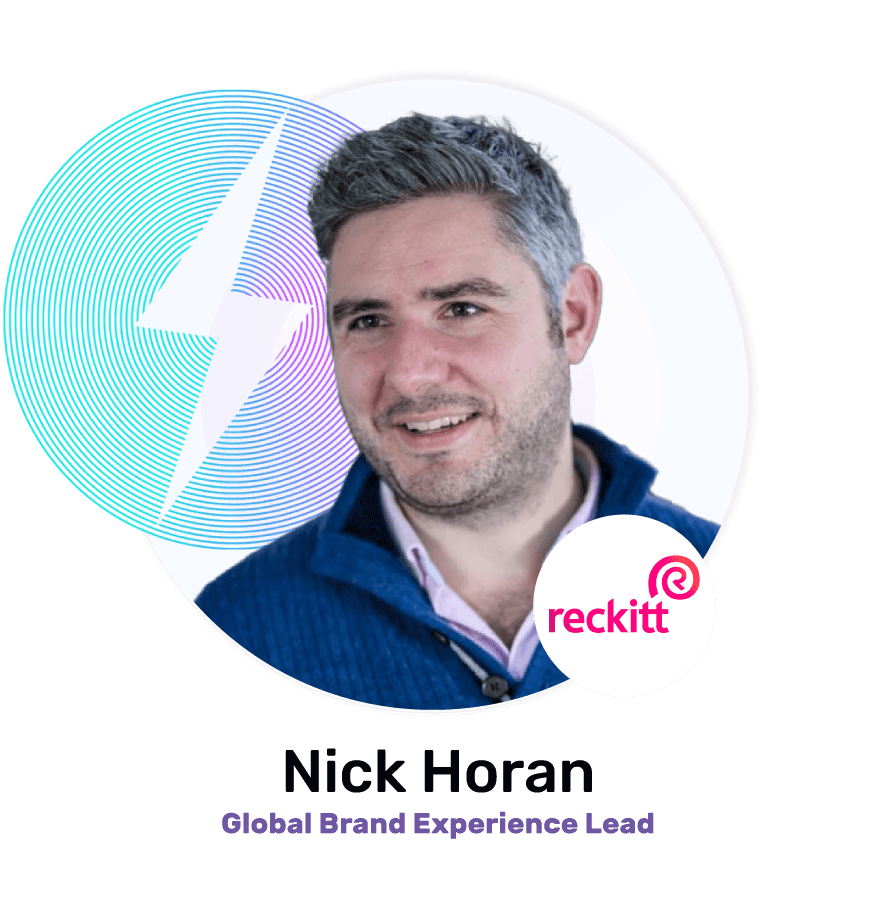The NOW Gen consumer is exposed to thousands of brands and interactions daily. In today’s episode, we embark on a journey to unravel the intricacies of this dynamic relationship and delve into some thought-provoking topics shaping the future of brand-consumer interactions with our special guest, Nick Horan, the Global Brand Experience Lead at Reckitt. Enjoy this episode recorded from 121’s, our sponsor, studio hub in Guadalajara, Mexico. From Nick Horan’s remarkable background and expertise in the field to the exponential increase in brand-consumer engagement, we’ll uncover the secrets behind giving customers unforgettable brand experiences. As we dive deep into today’s episode, get ready to ignite your passion for branding and consumer engagement!

Guest
Nick Horan
KEY POINTS:
- Nick’s background and experience.
- The increase in brand-consumer interaction.
- Giving customers memorable brand experiences.
- Understanding your brand’s personality.
- Innovation as a change that brings new value.
- Reverse instant gratification, build a crescendo with CX.
RELEVANT QUOTES:
“In the 1950s, people were exposed to something like 500 brands per day. And now that’s something like 5,000 today. It’s growing massively, the amount of interactions people have with brands at every given minute, second, whatever you wanna call it.”
“As brand owners, we have to be faster, and more agile to ensure that we’re giving people fantastic brand experiences that really are memorable. They’re distinctive and long-lasting. And speed is frankly, the enabler of us having more conversations with more people.”
“I think it’s super important to work with agencies such as yourself that allow us to explore new channels, new technologies, and so forth, to allow us to create those conversations, to create those meaningful moments with our consumers all around the world.”
“I think speed must be harnessed at the right points in projects. If you have spent enough time to really understand the foundations of what you are actively trying to achieve, you’ve laid the strategic intent, then actually that allows you to act with a lot more precision, with a lot more speed.”
“Speed for the sake of speed is pointless, you know? ’cause otherwise, you might just be a busy fool. But if you are utilizing it in the right way, it really allows a competitive advantage for brands.”
“I think, first of all, we’ve got to acknowledge that nine out of 10 innovations will die. And it’s kind of curious because operating at pace allows you to test and learn about innovations. It actually sets them up for success, but it also allows you to kill ideas that you might be in love with, but for whatever reason just won’t land properly.”
“For me, the first part, of good brand building is understanding what the brand stands for, what its purpose is, why it exists in the world, why consumers love it, and why they should be part of its community.”
“If you can’t really understand the key insight behind that, it becomes a significant problem for brand building. Full-stop. But if you really understand that insight well, it can act as an incredible foundation for brand building.”
“Now, the next part of it, in my view, is understanding the brand’s personalities, its behaviors, its values, and so forth, which is much more around tonality.”
“With global brand building, we have so many fantastic tools to then start to disseminate how the brand should behave in varying different situations.”
“Brand guardianship can be seen as the policing role, but it’s not good. Guardianship is about setting a set of parameters, a way of working that the business understands.”
“My role as, a brand experience lead Reckitt is about setting those principles, those values that people can utilize as a platform for building the brand in all kinds of different markets.”
“Brands previously were quite one-dimensional. They sat in one-dimensional spaces to a certain degree, simple channels, bricks, and mortar retail.”
“The world is changing quite significantly. Of course, we have more channels than ever before, and more conversations happening about brands. And whether you are there to be part of those conversations as a brand or not, they’re still going to happen.”
“Are they engaging with what target audiences are we aiming for in order to be quite focused on making sure that that journey is nailed in terms of trying to drive people from that first point of awareness of an interesting innovation through to that point of advocacy, that point in which they’ve fallen in love and are willing to kind of share their experiences with the world.”
“A very brilliant lecturer of mine many years ago said innovation is a change that brings new value to people. It’s a straightforward definition, but a change can be quite radical. It can be what people refer to as moonshots equally. It can be quite small.”
“When we’re talking about change, we need to understand what we’re changing for. What is that end goal? Why are we doing it? And I think that comes back to our previous conversation, that if you are clearly defined what your purpose is of your brand, now for Vanish, that’s about keeping clothing circulation for as long as possible.”
“It can be a small-scale marketing innovation that allows people to target specific user groups in their market. It can be something much more significant. It could be how you think about the products that are coming through in your innovation pipelines if you are in the research and development center.”
“But if you are clear on what that North Star is, it has the ability to cement so many different people within a business behind it and really drive cultural change within an organization.”
“I was sat there thinking this is brand personification. You are no longer talking to an individual representative of a brand. You are just talking to the brand directly. And this idea of personification is coming through in so many different channels.”
“You have to be really clear about what your brand stands for, what its personality is, and that defines things like its tone of voice. And you can have a lot of fun with that.”
“The first thing to acknowledge is you can’t do everything. You have to be always on in multiple different markets, but to a certain degree, you have to let go of control to allow people within their markets nuance the brand to their audiences.”
“Our brands operate across multiple different markets that have their own cultural nuances, different ways of talking to their users and so forth.”
“I guess a global seed, working with those markets to really understand the journeys that they want to take their users on, what kind of channels are their users consuming in terms of social, in terms of e-commerce, in terms of in store and so forth. There are commonalities.”
“And commonalities allow us to start thinking about what are the user journeys that we want to build, as we were talking about earlier, to take someone from the point of initial awareness to the point of advocacy that is gonna change per market.”
“I think instant gratification is a super interesting topic because actually you can flip it. You can see it as a slightly different opportunity. You can either reward people very immediately, or you can start to look at the points within that user journey where there’s quiet, where someone might not be interacting with their brand when they could be.”
“There is always going to be points within a journey that people will be waiting for something to happen for some sort of engagement with the brand to happen.”
“How do I take people on a journey through the point of awareness to the point of advocacy. And I think looking for those silent points are the kind of serious spaces that we can have genuine impact as marketeers within, within the world today, within the channels that people are consuming.”
“To a certain degree, we still have to start catering for that kind of instant gratification. But being smart in the way you reward people at different parts of the journey, it allows you to psychologically tap into all kinds of reward centers in the mind.”
“And I think keeping your eye on these quiet moments, that actually could be really useful to have a conversation as a brand with someone, or it can target those reward centers. It can build excitement, and it can do all kinds of different things. And those are the areas that are really exciting in terms of media and marketing innovation.”
“So you can then start to see how people, or how brands are actually taking maybe what’s a problem, or a conversation saying, come over here, let’s have a chat about that. And then it starts to fuel things like product innovation.”
“You can actually learn a lot. You get a lot of insight, you get a lot of reward. Whereas if you don’t engage in those conversations, if you are not part of them, you won’t gain that insight.”
“And that’s why I’m super passionate that if there are conversations happening, the brand should be part of it. And to our conversation earlier, the brand can own it. They can be personified in it. They can have their own unique humor, their own unique personality, their own unique seriousness, if that’s kind of what they’re about.”
“I think all these emerging channels are just opportunities to have much richer, much more involved conversations with the users and the communities of our brands.”
“I think for me it’s about understanding that brands can be a platform for good innovation.”
“Innovation can also be micro innovation. It can also be macro innovation and understanding where you want to take your brand to be a force for good.”
“I was considering this the other day that actually there’s a massive innovation that’s happening in the Barbie movie right now in terms of how they’re utilizing CGI and AI for making super immersive worlds that are going to fundamentally change the world of filmography. But no one’s talking about that.”
“You can create something super special, super viral, that spreads a message all over the world and hopefully gives people a bit of nostalgia at the same time.”

